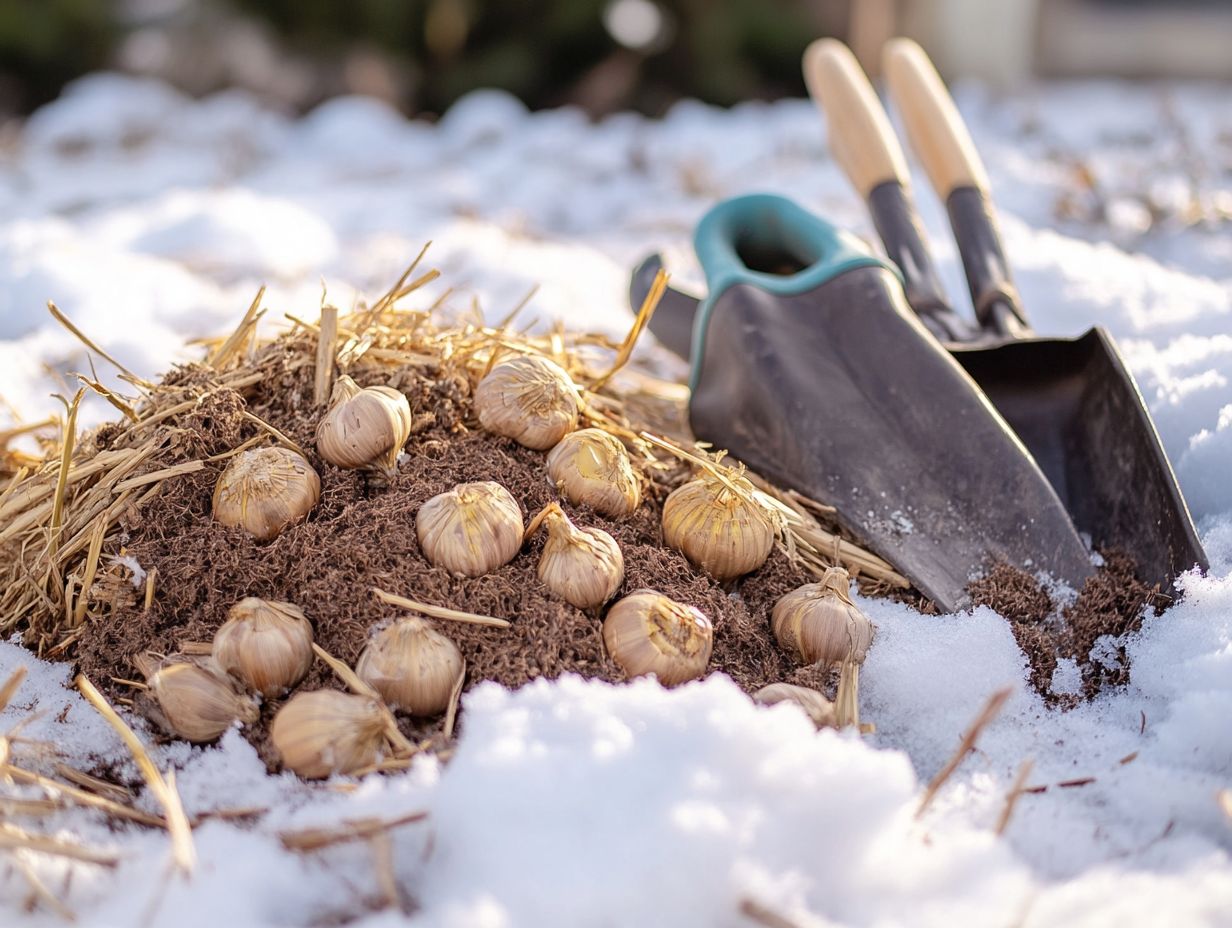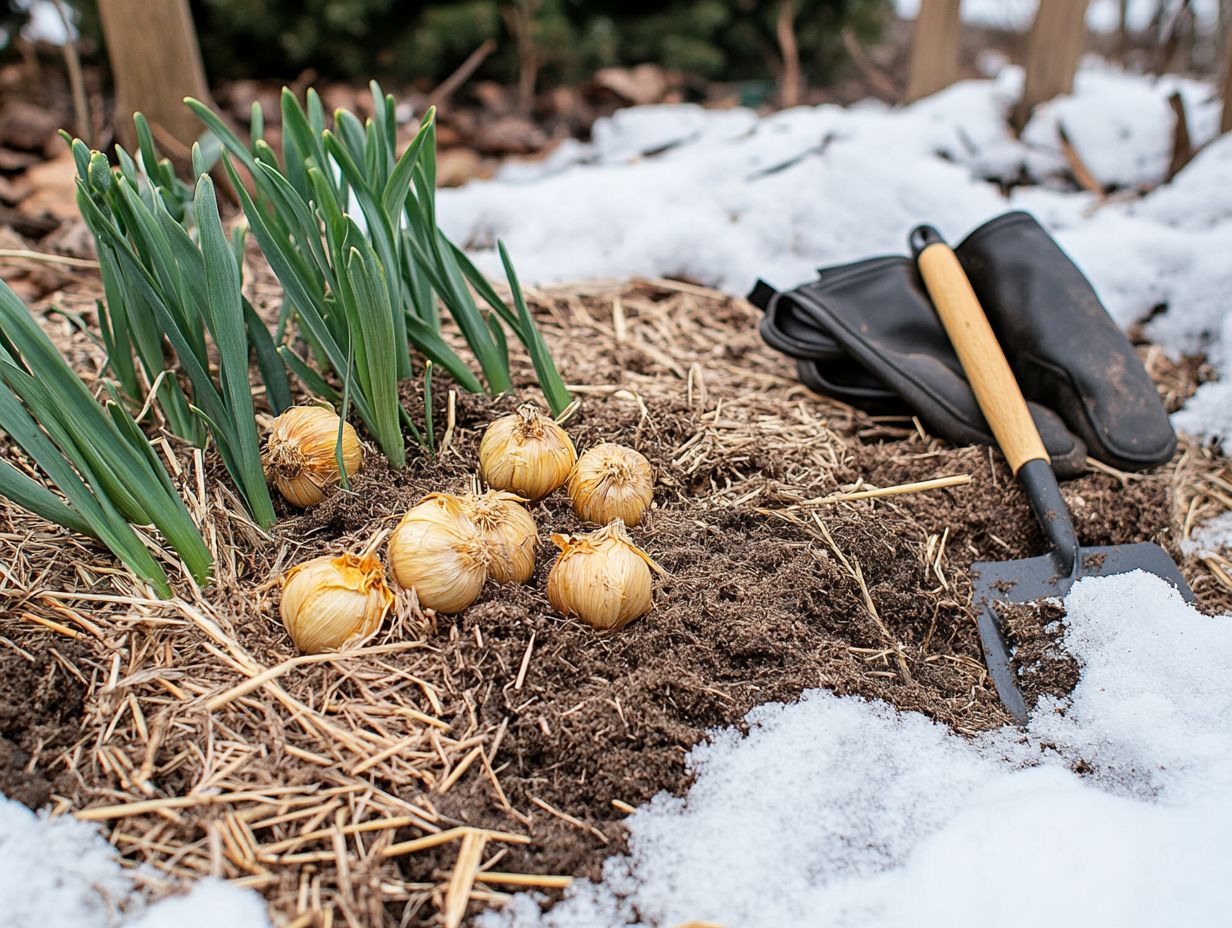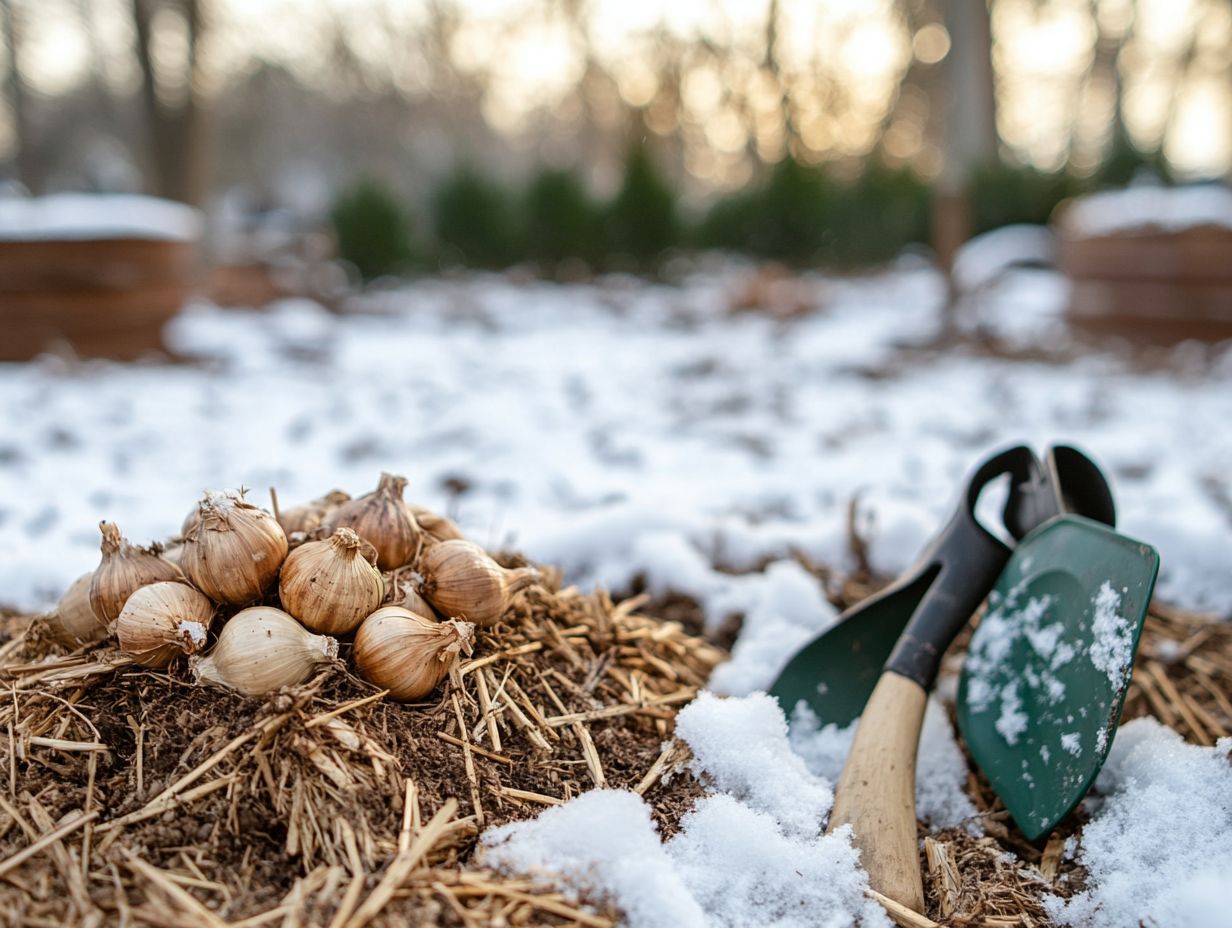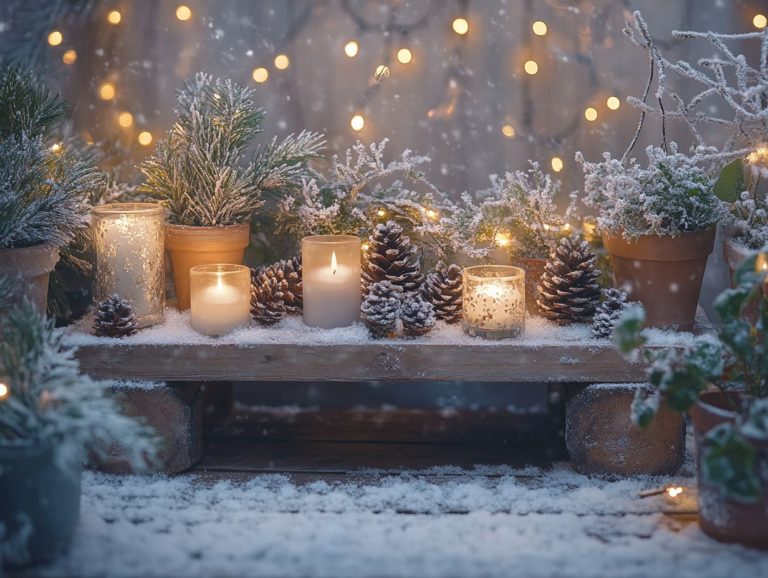How to Protect Bulbs During Winter
As winter approaches, you ll encounter the challenge of safeguarding your cherished bulbs from the harsh elements. It s essential to understand the various types of bulbs and their distinct characteristics for effective winter care, including proper ways to store bulbs during winter storage.
Ready to protect your bulbs? This guide will show you how to prepare and insulate them, offering strategies to minimize damage and tips for packing bulbs safely.
Discover how to replant and nurture them back to life when spring arrives. Get ready to ensure your bulbs not only survive but thrive through the winter chill by mastering bulb care and maintenance.
Contents
- Key Takeaways:
- Understanding Winter Bulbs
- Preparing Bulbs for Winter
- Protecting Bulbs During Winter
- Dealing with Winter Damage
- Overwintering Bulbs
- Bringing Bulbs Back in the Spring
- Frequently Asked Questions
- How can I protect bulbs during winter?
- Can I leave bulbs in the ground during winter?
- What types of bulbs need extra protection during winter?
- How do I know if my bulbs have been damaged by winter weather?
- Can I use plastic to protect my bulbs during winter?
- When should I remove the winter protection from my bulbs?
Key Takeaways:

- Prepare your bulbs for winter to ensure they survive. Mulch and cut back their foliage before the cold hits.
- Use straw or burlap to shield your bulbs from freezing temperatures.
- If you see winter damage, act quickly! Replant or care for your bulbs to help them bounce back in spring.
Understanding Winter Bulbs
Understanding winter bulbs is essential for any gardener eager to safeguard their delicate plants during the colder months. This ensures they thrive and bloom beautifully come spring. It s important to know about tender bulbs and their specific care needs.
It s easy to overlook the unique care requirements for different bulb types, including tender varieties like Amaryllis and Dahlia, alongside summer bulbs such as Gladiolus and Canna Lily. Don’t forget about options like Elephant Ear for a stunning garden display.
Mastering proper winter storage techniques not only prolongs the life of your bulbs but also sets the stage for a vibrant resurgence in spring. Focus on caring for your bulbs to achieve ongoing success in your gardening endeavors.
Types of Bulbs and Their Characteristics
When gardening, grasping the nuances of different bulb types is crucial for a successful planting and blooming season. Among these, you ll find tender bulbs like Dahlia and Canna Lily, which truly shine during the summer, while spring-blooming options such as Peonies and Calla Lily benefit from a good application of compost for better growth.
Tender bulbs thrive in warm temperatures, so it’s best to plant them only after the frost has passed. Check bulbs regularly during their growth for optimal health. They love basking in full sun and require well-drained soil to reach their full potential.
On the flip side, Peonies, known for their opulent blooms, prefer cooler climates and well-amended soil that retains a bit of moisture. They require careful handling. Calla Lilies, with their graceful trumpet-shaped flowers, do wonderfully in slightly shaded areas and benefit from consistent watering to ensure robust growth.
By understanding these essential characteristics and the proper way to store bulbs, you can select the perfect bulbs to transform your landscape, creating a dazzling display of colors and textures throughout the gardening seasons.
Preparing Bulbs for Winter
Preparing bulbs for winter requires you to follow several crucial steps that ensure their survival through the colder months. This includes cleaning bulbs effectively and understanding how to cure them to enhance their dormancy.
Adhering to best practices for bulb care and maintenance can influence their viability and health come spring, ensuring a successful planting season ahead. A well-prepared bulb not only endures winter dormancy but also thrives when it s time to bloom again, making proper preparation a vital component of successful gardening practices.
Get ready to give your bulbs the care they deserve this winter! Start today, and watch them flourish in spring.
Steps to Take Before Winter Hits
Before winter sets in, it s essential for you to inspect your bulbs for any signs of damage or disease. This ensures they re in prime condition for their winter storage period, including checking bulbs for rot or decay. Take a moment to examine each bulb closely and follow the right procedures for packing bulbs to prepare them for dormancy, a period when the bulbs are inactive and not growing. This might include trimming and cleaning to extend their lifespan and ensure proper handling during storage.
Always check their surroundings. The right moisture and temperature can make all the difference! Once inspected, lay each bulb out in a well-ventilated area to dry completely before transferring them to a cool, dark place, suitable for optimal bulb dormancy. Using breathable bags or boxes will help prevent rot while creating a stable environment for your stored bulbs.
Label your bulbs. Note the variety and planting date. This makes future planting a breeze and enhances your gardening tips for effective organization. Following these steps will ensure your bulbs stay vibrant and ready for planting come spring, underlining the importance of meticulous storage and regular checks as part of their care and maintenance.
Protecting Bulbs During Winter

Protecting bulbs during winter is crucial to prevent damage. It demands a thoughtful approach to insulation techniques tailored to the unique needs of delicate plants, and using tips for forced bulbs in cold climates can reinforce the importance of local gardening centers for expert advice.
You might find yourself seeking guidance from Cleveland State University or Northern Kentucky University, where expert advice can help you safeguard your bulbs.
By taking these precautions, you can ensure they remain healthy and viable, ready to flourish in the next planting season. This ensures the best bulb care for your garden.
Insulation Techniques and Strategies
Utilizing effective insulation techniques is crucial for winter storage of your bulbs. It can significantly impact their survival and vitality during the cold months, emphasizing the need for proper techniques in bulb maintenance. Consider using organic gardening materials like mulch or straw, which provide warmth and control moisture effectively, ensuring better survival rates for your bulbs.
A layer of compost does wonders, keeping soil temperatures stable while enriching the environment to promote healthy bulb dormancy during winter storage. You might also want to think about using recycled cardboard or burlap sacks as protective barriers against frost. These options are great for maintaining bulb life. They not only retain essential moisture but also help prevent rot, a key consideration in bulb care.
Implementing these organic methods enhances the resilience of your bulbs through the harsh winter, aligning your gardening practices with sustainability and promoting effective plant storage. This helps your plants thrive. Focusing on these details guarantees your bulbs will come back stronger than ever when spring finally arrives, ready for the next planting season.
Dealing with Winter Damage
Addressing winter damage is an essential aspect of bulb care and maintenance as you prepare for the new spring season. It involves conducting thorough assessments of bulb types to gauge the extent of any harm and developing effective strategies to tackle the damage.
Since each bulb type has its unique characteristics, different approaches to bulb maintenance may be necessary. By following specific gardening tips, including proper ways to check bulbs, you can successfully restore health and vitality to your damaged plants, ensuring they flourish in the coming seasons.
Assessing and Addressing Damage
Assessing damage to your bulbs requires a careful check to identify any signs of rot or disease that could harm their lifespan and blooming potential in the upcoming season. Timely intervention is key to taking care of bulbs, ensuring their health and productivity.
Start with a thorough inspection of each bulb, looking for discoloration, mushiness, or unusual odors that may indicate decay. These signs are crucial for effective bulb maintenance. Remove any problematic bulbs quickly to stop infection from spreading, which helps your remaining bulbs thrive. Ensure that they are planted in well-draining soil, as poor drainage can worsen rot and affect their health.
Use organic fungicides, which are natural treatments that fight plant diseases, as a preventive measure to boost the health of your remaining bulbs during the storage period. Establish a regular watering schedule and keep the foliage clean to improve both the longevity and productivity of your bulbs.
Overwintering Bulbs
Successfully overwintering bulbs hinges on understanding proper storage techniques and packing strategies to keep them healthy during their dormancy.
By utilizing effective winter storage methods and employing meticulous packing strategies, including checking bulbs frequently, you can greatly enhance their maintenance and lifespan.
How to Store Bulbs for the Winter

When deciding how to store bulbs for the winter, pack them right and ensure they re clean to avoid any rot or damage that can shorten their bulb life. Using breathable materials can significantly improve their winter storage experience.
- Carefully inspect each bulb and discard any that show signs of mold or decay. One unhealthy bulb can jeopardize the rest, so proper care is crucial.
- Gently brush off excess soil and let them dry completely in a shaded area to reduce moisture. This step is critical for maintaining bulb health.
- Once they re dry, choose materials like paper bags or wooden crates to promote air circulation and minimize condensation, ensuring better storage conditions.
- Pack the bulbs with minimal contact, using straw or shredded newspaper as cushioning. This keeps them snug yet comfortable, preparing them for a vibrant return in the spring.
Bringing Bulbs Back in the Spring
Bringing bulbs back to life in the spring requires a thoughtful approach to replanting, ensuring each bulb gets the attention it deserves for healthy growth and a stunning bloom after proper care during winter.
Applying effective gardening tips and proper bulb care techniques, including checks on bulb health, will enhance their revitalization after winter.
Tips for Successful Replanting
Successful replanting of bulbs hinges on specific tips tailored to each type’s unique characteristics. Consider the ideal conditions needed during the planting season; the right depth, spacing, and sunlight can enhance their blooming potential.
Explore the individual needs of each bulb variety. For example, some bulbs thrive in well-drained soil, while others benefit from a layer of mulch that retains moisture.
Timing is also vital; early bloomers should be planted in autumn, while late bloomers may prefer a spring planting. Understanding their natural habitat helps recreate an environment that fosters growth.
By focusing on these factors, you can cultivate a vibrant display of flowers that revitalizes any landscape.
Frequently Asked Questions
How can I protect bulbs during winter?
To protect bulbs in winter, follow these easy steps. Plant them at the right time and depth.
Add a layer of mulch to help keep them warm. You can also cover the area with burlap or frost cloth for extra protection.
Can I leave bulbs in the ground during winter?

It is usually best to dig up bulbs and store them in a cool, dry place during winter. Some hardy bulbs can stay in the ground as long as they are properly protected.
What types of bulbs need extra protection during winter?
Tender bulbs like dahlias, gladiolus, and canna lilies are more vulnerable to winter damage. These bulbs should be dug up and stored indoors during the cold months.
How do I know if my bulbs have been damaged by winter weather?
If your bulbs have been damaged, watch for signs like mold, mushy spots, or shriveled and discolored leaves. You might also see signs of pests or rodents feeding on the bulbs.
Can I use plastic to protect my bulbs during winter?
While plastic can offer some protection, it s not the best choice for covering bulbs. Plastic can trap moisture, causing rot and restricting airflow, which can lead to mold and mildew.
When should I remove the winter protection from my bulbs?
Keep an eye on the weather! Remove the winter protection when spring temperatures start to rise.
Don t leave the protection on too long! Doing so can cause the bulbs to overheat and rot.






